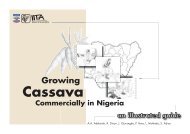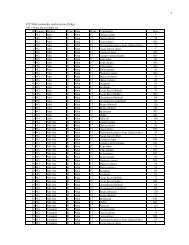Pig Fattening Technique in Nigeria - Cassavabiz.org
Pig Fattening Technique in Nigeria - Cassavabiz.org
Pig Fattening Technique in Nigeria - Cassavabiz.org
Create successful ePaper yourself
Turn your PDF publications into a flip-book with our unique Google optimized e-Paper software.
COMMERCIAL LIVESTOCK PRODUCTION GUIDE SERIES<br />
<strong>Pig</strong> <strong>Fatten<strong>in</strong>g</strong> <strong>Technique</strong><br />
<strong>in</strong> <strong>Nigeria</strong><br />
United States Agency for<br />
International Development<br />
www.usaid.gov<br />
Information and Communication Support<br />
for Agricultural Growth <strong>in</strong> <strong>Nigeria</strong><br />
www.ics-nigeria.<strong>org</strong><br />
ICS-<strong>Nigeria</strong>
Rear<strong>in</strong>g <strong>Pig</strong>s <strong>in</strong> <strong>Nigeria</strong><br />
Choice of Land<br />
A well-dra<strong>in</strong>ed land is needed both for hous<strong>in</strong>g and paddock<strong>in</strong>g. This will<br />
m<strong>in</strong>imize disease outbreak and parasitism.<br />
BREEDS<br />
•Large White<br />
• Large White x Local (Hybrid)<br />
• Hampshire x Local (Hybrid)<br />
HOUSING<br />
This is determ<strong>in</strong>ed by the class of the pig. Permanent pig houses should be<br />
cool, durable and easy to clean. Floor should be made of concrete, while<br />
roof<strong>in</strong>g could, be made of corrugated iron sheets covered with bamboo<br />
leaves/grass or adex. The free-range system may be used for the fatten<strong>in</strong>g,<br />
but the range will need partition<strong>in</strong>g with fenc<strong>in</strong>g materials <strong>in</strong>to paddocks of<br />
suitable sizes. Farrow<strong>in</strong>g pen is designed to conta<strong>in</strong> the sow and the piglet.<br />
With little restriction and presence of guard rails (open pens) or <strong>in</strong> a conf<strong>in</strong>ed<br />
space immediately before, and after farrow<strong>in</strong>g. Pregnant or dry sow can<br />
Roof<strong>in</strong>g<br />
made of<br />
corrugated iron<br />
sheets covered<br />
with bamboo<br />
leaves.<br />
2
e kept <strong>in</strong> pens designed to accommodate 3–5 animals (3 m x 2 m). An<br />
open pen with feeder runn<strong>in</strong>g from wall or partitioned, so that <strong>in</strong>dividual<br />
sows have stall and feed<strong>in</strong>g area and a common passage should suffice.<br />
The boar pen is of similar design to accommodate a boar and a sow at<br />
mat<strong>in</strong>g. <strong>Fatten<strong>in</strong>g</strong> pens must be such as to m<strong>in</strong>imize loss of feed result<strong>in</strong>g<br />
from spillage and contam<strong>in</strong>ation. A typical fatten<strong>in</strong>g pen should be big<br />
enough to accommodate 8–12 pigs of the same age and weight. Pens 8 m<br />
x 4 m with feeder runn<strong>in</strong>g from wall to wall, partitioned at 25 cm <strong>in</strong>terval<br />
with iron rods to prevent pigs from slipp<strong>in</strong>g <strong>in</strong> the feed arcok.<br />
Management procedure<br />
A boar should be used spar<strong>in</strong>gly from 1 year of age. He should be able<br />
to mate 2 females per<br />
week, each mated 2–3<br />
times and should last<br />
2–3 years work<strong>in</strong>g life.<br />
Pregnant pigs farrow<br />
with<strong>in</strong> 2 days before<br />
or after 115 days of<br />
pregnancy.<br />
Never house big and small ones together <strong>in</strong> the same pen.<br />
WEANERS<br />
Wean piglets between<br />
25 and 56 days of<br />
age.<br />
Remove dam, never<br />
piglets first.<br />
Never house big and<br />
small ones together <strong>in</strong><br />
the same pen.<br />
Supply heaps of grass<br />
to prevent tail-bitt<strong>in</strong>g,<br />
navel suck<strong>in</strong>g or iod<strong>in</strong>e<br />
deficiency.<br />
Provide plenty of water<br />
and high concentrate<br />
feed<strong>in</strong>g.<br />
3
GROWERS<br />
Rear axes <strong>in</strong> separate pen between 10 and 12 weeks of age.<br />
Feed growers ration until 30 kg.<br />
FATTENERS<br />
Transfer to fatteners pen from 50 –100 kg live weight.<br />
Change to fattener diet:<br />
Select good females based on records as replacement for unproductive<br />
females among breed<strong>in</strong>g stock. In select<strong>in</strong>g, the po<strong>in</strong>ts to look for are:<br />
• fast growth rate<br />
• good stand, no deformityva<br />
• not less than 14 visible prom<strong>in</strong>ent nipples on the underl<strong>in</strong>e<br />
• decility<br />
• unwanted gilts and boars should be fattened out to slaughter as fresh pork<br />
(50– 70 kg) or baconers (90 -–120 kg).<br />
FEEDING<br />
Suck<strong>in</strong>g pig: 24-28% prote<strong>in</strong> feeds.<br />
Feed needs extra vitam<strong>in</strong> premix to tide over diarrhea.<br />
Weaner requires more energy, less prote<strong>in</strong> than suck<strong>in</strong>g piglets, 18–20%<br />
prote<strong>in</strong>.<br />
GROWER<br />
Could be fattened out on similar diet but for greater lean meat deposition,<br />
requires a little bit of food restriction or addition of fibrous feed<strong>in</strong>g stuffs <strong>in</strong><br />
the diet to dilute the energy <strong>in</strong>take and reduce rate of fat deposition <strong>in</strong> the<br />
carcass. For prote<strong>in</strong>, soybean can replace up to 60% of the prote<strong>in</strong>, while<br />
cassava (dried or boiled) can replace much of the energy. Brewers’ wet gra<strong>in</strong>s<br />
are cheaper than the dried ones. Where farm is accessible to the wet gra<strong>in</strong>s,<br />
a slopp<strong>in</strong>g concrete floor should be made and the wet gra<strong>in</strong>s covered with<br />
polyethylene sheets, use up with<strong>in</strong> a week.<br />
Diseases<br />
Common diseases <strong>in</strong>clude baby piglet anaemia, good management is<br />
essential.<br />
4
DEWORM<br />
Always consult a veter<strong>in</strong>arian.<br />
Keep a good record of your animals performance e.g, number of pigs born,<br />
number dead, number of litters raised per sow, number of sows mated per<br />
boar per year. Feeds at the different prote<strong>in</strong> levels could be compounded on<br />
farm from maize or s<strong>org</strong>hum, groundnut cake or soybean meal or palm kernel<br />
cake, brewers dried gra<strong>in</strong>, rice bran, vitam<strong>in</strong>-m<strong>in</strong>eral premix, bare meal salt,<br />
and palm oil.<br />
Keep a good record of your animals performance<br />
5
CAUTION: MOST DISEASE OUTBREAKS OCCUR DURING THE<br />
WEEKEND. BE WARNED.<br />
The <strong>in</strong>formation for this Production Guide was obta<strong>in</strong>ed with permission from<br />
Extension Research Liaison and Tra<strong>in</strong><strong>in</strong>g Unit<br />
National Horticultural Research Institute (NIHORT)<br />
P M B 5432,<br />
Idi - Ish<strong>in</strong>, Ibadan.<br />
6
About ICS-<strong>Nigeria</strong><br />
Information and Communication Support for Agricultural Growth<br />
<strong>in</strong> <strong>Nigeria</strong> (ICS-<strong>Nigeria</strong>) is a project which aims to <strong>in</strong>crease the quantity<br />
and quality of <strong>in</strong>formation available for <strong>in</strong>creased agricultural production,<br />
process<strong>in</strong>g, and market<strong>in</strong>g and also strengthen the capacity of farmer assistance<br />
<strong>org</strong>anizations to package and dissem<strong>in</strong>ate <strong>in</strong>formation and agricultural<br />
technologies to farmers for the alleviation of rural poverty.<br />
In the recent past, <strong>in</strong>vestment <strong>in</strong> the support services to <strong>Nigeria</strong>n agriculture has<br />
been neglected with the result that this sector has not realized its full potential<br />
to contribute to the prosperity and economic development of the country.<br />
Meanwhile, <strong>in</strong>creas<strong>in</strong>g population pressure and the accompany<strong>in</strong>g need to<br />
<strong>in</strong>tensify agricultural production is lead<strong>in</strong>g to erosion of the natural resource base<br />
on which agriculture depends.<br />
The susta<strong>in</strong>ability of production is threatened by a vicious cycle of decl<strong>in</strong><strong>in</strong>g soil<br />
fertility and <strong>in</strong>creas<strong>in</strong>g problems of pests, diseases, and weeds. Moreover, the<br />
lack of knowledge on how to add value through proper storage, process<strong>in</strong>g, and<br />
market<strong>in</strong>g impedes agricultural growth.<br />
Promis<strong>in</strong>g technologies exist to address these problems, but their adoption is<br />
constra<strong>in</strong>ed by a lack of <strong>in</strong>formation packaged <strong>in</strong> appropriate formats, and poor<br />
communication channels for this <strong>in</strong>formation, between farmers and the research,<br />
extension, and education <strong>org</strong>anizations that are supposed to address these<br />
issues.<br />
ICS-<strong>Nigeria</strong> aims to assist <strong>in</strong> meet<strong>in</strong>g these challenges by develop<strong>in</strong>g<br />
appropriate format materials for dissem<strong>in</strong>at<strong>in</strong>g <strong>in</strong>formation and agricultural<br />
technologies to target user groups, while <strong>in</strong>creas<strong>in</strong>g capacity of farmer assistance<br />
<strong>org</strong>anizations to produce <strong>in</strong>formation materials. At the same time, communication<br />
channels will be re<strong>in</strong>forced so that <strong>in</strong>formation fl ow is enhanced.<br />
Agricultural technologies have been selected on the basis that they will lead<br />
to agricultural commercialization thereby enhanc<strong>in</strong>g rapid <strong>in</strong>come generation<br />
for farmers and private sector practitioners. The project is tak<strong>in</strong>g advantage<br />
of exist<strong>in</strong>g agricultural development programs <strong>in</strong> <strong>Nigeria</strong>, national research<br />
<strong>in</strong>stitutes, and <strong>in</strong>ternational research <strong>in</strong>stitutes <strong>in</strong> and out of <strong>Nigeria</strong> to identify<br />
these technologies. The project is also tak<strong>in</strong>g advantage of exist<strong>in</strong>g successful<br />
partnerships aris<strong>in</strong>g from recent and ongo<strong>in</strong>g programs to enhance <strong>in</strong>formation<br />
fl ow.<br />
ICS-<strong>Nigeria</strong> is funded by USAID.<br />
International Institute<br />
of Tropical Agriculture<br />
www.iita.<strong>org</strong>















